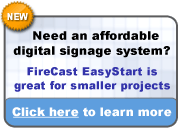Dave Haynes of sixteen-nine fame has made no secret of his recent ride through the economic turbulence, so the entrepreneur in me is thrilled to see him casting off the shackles of formal employment to pursue a life of adventure and mystique as a small business owner. Given his strong writing skills, popular brand (in our industry, at least) and large rolodex, he's basically taking his writing services on the road, first come first served:
A new media communications firm, called pressDOOH, launched today to help companies in the fast-evolving digital signage and digital out of home (DOOH) industries break out from a highly competitive pack.So if you're in the digital signage business, you have lots of stuff that you want the world to know about, and you can't write (which, sadly, I've found is often the case), Dave's services seem well worth checking out. And hey, you'll be paying him in Canadian dollars, so that's only like $0.85/each in real money!
pressDOOH (www.pressdooh.com) is specifically positioned to help established and start-up companies develop effective communications material, such as press releases, white papers and case studies, to help build market awareness and drive new business. What sets pressDOOH apart from established public relations and communications firms is that the company has a deep history and understanding of the industry.
The founder and principal of pressDOOH, Dave Haynes, is a well-known industry pioneer who made the leap from mainstream print journalism to new media in the mid-'90s and has been involved in the digital signage and DOOH sectors for more than a decade. Haynes is the writer behind Sixteen:Nine, one of the nascent industry's most widely-read and respected blogs.
"Writing is in my DNA, and this is really just a return to my roots," says Haynes, who for the past few years has done senior-level business development for two of the biggest names in the software side of the industry. "In fact, I'm writing this right now. And now I'm even writing about writing. Writing writing writing writing writing." (that last part was made up to see if anybody's still reading).


 I continue to be a fan of the work of Artisan Live, the digital signage-focused unit of Canadian ad/marketing firm Artisan Complete. Their content continues to be among the best I've seen in the retail digital signage space, and every year they win a bunch of new awards to prove it.
I continue to be a fan of the work of Artisan Live, the digital signage-focused unit of Canadian ad/marketing firm Artisan Complete. Their content continues to be among the best I've seen in the retail digital signage space, and every year they win a bunch of new awards to prove it. Some day I hope to sell a line of digital signage trading cards. On the front is a picture of the screen. One the back, the vital stats. I'm not sure whether I'll go with a traditional baseball card-style collect-them-for-the-sake-of-collecting model, or something more along the lines of Magic: The Gathering where networks duke it out for the title of Grand Champion (or something). Either way, it looks like CARE Media would be one to have (though perhaps not its rookie year), if you believe
Some day I hope to sell a line of digital signage trading cards. On the front is a picture of the screen. One the back, the vital stats. I'm not sure whether I'll go with a traditional baseball card-style collect-them-for-the-sake-of-collecting model, or something more along the lines of Magic: The Gathering where networks duke it out for the title of Grand Champion (or something). Either way, it looks like CARE Media would be one to have (though perhaps not its rookie year), if you believe 
 Subscribe to this blog
Subscribe to this blog Follow Bill Gerba on Twitter
Follow Bill Gerba on Twitter